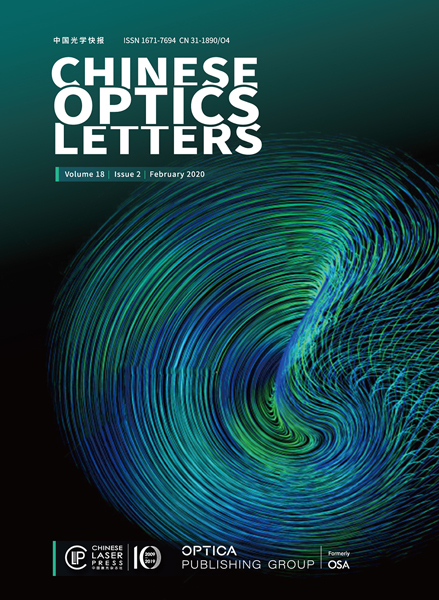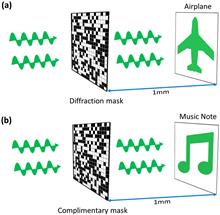 View fulltext
View fulltext
Complementary metasurfaces based on Babinet’s principle have shown remarkable performance in optical applications like polarization conversion and split ring resonators by dynamically reversing the properties of light in both transmission and reflection modes. However, complementary diffractive metasurfaces for different holographic images have not yet proven to be effective because Babinet’s principle predicts identical diffraction patterns from complementary surfaces. Here, we report carefully designed complementary metasurfaces consisting of an engineered metallic aluminum layer sitting on a transparent quartz substrate. Upon illumination, both complementary devices output entirely different diffractive intensity profiles from each other, yielding two holographic images at visible wavelengths from 430 nm to 650 nm. It provides experimental evidence for encoding two images into complementary metasurfaces, indicating an exception of Babinet’s principle in the Fresnel region of complementary apertures.
Integrated diffractive optical neural networks (DONNs) have significant potential for complex machine learning tasks with high speed and ultralow energy consumption. However, the on-chip implementation of a high-performance optical neural network is limited by input dimensions. In contrast to existing photonic neural networks, a space-time interleaving technology based on arrayed waveguides is designed to realize an on-chip DONN with high-speed, high-dimensional, and all-optical input signal modulation. To demonstrate the performance of the on-chip DONN with high-speed space-time interleaving modulation, an on-chip DONN with a designed footprint of 0.0945 mm2 is proposed to resolve the vowel recognition task, reaching a computation speed of about 1.4×1013 operations per second and yielding an accuracy of 98.3% in numerical calculation. In addition, the function of the specially designed arrayed waveguides for realizing parallel signal inputs using space-time conversion has been verified experimentally. This method can realize the on-chip DONN with higher input dimension and lower energy consumption.
In this work, we demonstrate the spectral manipulation in an ultrafast fiber laser system that generates ultrashort pulses with a repetition rate of 1.2 GHz and two switchable modes—a 1064-nm fundamental laser mode with a maximum output power of 66.6 W, and a 1125-nm Raman laser mode with a maximum output power of 17.23 W. The pulse width, beam quality, and power stability are carefully characterized. We also investigate a method to switch between the two modes by manipulating the duty cycle of the modulation signal. It is anticipated that this bi-mode ultrafast fiber laser system can be a promising ultrafast laser source for frontier applications, such as micromachining, bioimaging, and spectroscopy.
In this work, we demonstrate the phonon-assisted vibronic lasing of a Yb-doped sesquioxide Yb:LuScO3 crystal. The electron–phonon coupling process was analyzed and the Huang-Rhys factor S was calculated to be 0.75 associated with the fluorescence spectrum at room temperature. By a rational cavity design to suppress lasing below 1100 nm, a continuously spectral tunability from 1121 to 1136 nm was realized in a Yb:LuScO3 laser, which represents the longest achievable wavelength in the Yb-doped sesquioxide lasers. Moreover, the Raman spectrum indicated that the Eg phonon mode with a frequency of 472 cm-1 was mainly devoted to the phonon-assisted transition process. This work broadens the achievable laser spectrum of Yb-doped sesquioxide, and suggests that the multiphonon–electron coupling strategy should be universal for other laser materials.
A high efficiency, low threshold, high repetition rate H-β Fraunhofer line light at 486.1 nm was demonstrated. A high-efficiency KTP optical parametric oscillator was achieved by double-pass pumping with a high-maturity 5 kHz 532 nm laser. Thanks to the efficient intracavity frequency doubling of the circulating signal wave by a BIBO crystal, the threshold pump power of the 486.1 nm output was 0.9 W, and the maximum output power of 1.6 W was achieved under the pump power of 7.5 W. The optical–optical conversion efficiency was 21.3%, with the pulse duration of 45.2 ns, linewidth of ∼0.12 nm, and beam quality factor M2 of 2.83.
This study entailed the development of a high-gradient modulation of microbunching for traditional radiation frequency accelerators using a minimized system driven by a relativistic Laguerre–Gaussian (LG) laser in three-dimensional particle-in-cell (PIC) simulations. It was observed that the LG laser could compress the transverse dimension of the beam to within a 0.7 µm radius (divergence≈4.3 mrad), which is considerably lower than the case tuned by a Gaussian laser. In addition, the electron beam could be efficiently modulated to a high degree of bunching effect (>0.5) within ∼21 fs (∼7 μm) in the longitudinal direction. Such a high-gradient density modulation driven by an LG laser for pre-bunched, low-divergence, and stable electron beams provides a potential technology for the system minimization of X-ray free-electron lasers (XFELs) and ultrashort-scale (attosecond) electron diffraction research.
By its unparalleled capacity to manipulate optical parameters, metasurfaces demonstrate the ability to simultaneously manipulate the amplitude and phase of incident light. Exhibiting both near-field nanoprinting images and far-field holography images is a quintessential illustration of this capability. In preceding investigations, image multiplexing commonly transpires within the single polarization state or orthogonal polarization states, thereby exhibiting a deficiency in terms of information security when contrasted with the nonorthogonal polarization states. In this research, a multifunctional metasurface with the capability of exhibiting four-channel images has been proposed by using a nanobrick as a quarter-wave plate. Through the adjustment of the orientation angles of each nanobrick, nanoprinting can be displayed under both linearly and circularly polarized light. Building on this, the propagation phase is combined with the geometric phase to generate diverse phase delays, enabling the metasurface to be multiplexed under two nonorthogonal polarization states to achieve four-channel image displays. Intriguingly, bidirectional nanoprinting and bidirectional holography can be achieved by altering the direction of incidence polarization states. The proposed metasurface platform can open new possibilities for creating compact multifunctional optical devices, while also enhancing applications in multichannel image displays, information anticounterfeiting, and encryption.
Here, we present a study of the effective piezoelectric constant (e14e) temperature dependence in strained [111]-oriented zinc-blende quantum wells (QWs) embedded within a semiconductor optical amplifier (SOA). We determined e14e using a method that was insensitive to the segregation phenomenon and to the temperature dependence of the bandgap energy, which required neither fitting parameters nor temperature-dependent expressions for energy and out-of-plane effective masses of electrons and heavy holes. An e14e=-0.0534±0.0040 C · m-2 at 23°C was obtained for an SOA with 1.2 nm [111]-oriented strained In0.687Ga0.313As/In0.807Ga0.193As0.304P0.696 QWs. Unlike previously published research, where e14e magnitude increased as temperature rised, we extracted an e14e magnitude that decreased as temperature increased.
One of the major difficulties in realizing a high-dimensional frequency converter for conventional optical vortex (COV) modes stems from the difference in ring diameter of the COV modes with different topological charge numbers l. Here, we implement a high-dimensional frequency converter for perfect optical vortex (POV) modes with invariant sizes by way of the four-wave mixing (FWM) process using Bessel–Gaussian beams instead of Laguerre–Gaussian beams. The measured conversion efficiency from 1530 to 795 nm is independent of l at least in subspace l∈{-6,…,6}, and the achieved conversion fidelities for two-dimensional (2D) superposed POV states exceed 97%. We further realize the frequency conversion of 3D, 5D, and 7D superposition states with fidelities as high as 96.70%, 89.16%, and 88.68%, respectively. The proposed scheme is implemented in hot atomic vapor. It is also compatible with the cold atomic system and may find applications in high-capacity and long-distance quantum communication.
The cavity quantum electrodynamics (QED) system is a promising platform for quantum optics and quantum information experiments. Its core is the strong coupling between atoms and optical cavity, which causes difficulty in the overlap between the atoms and the antinode of optical cavity mode. Here, we use a programmable movable optical dipole trap to load a cold atomic ensemble into an optical fiber microcavity and realize the strong coupling between the atoms and the optical cavity in which the coupling strength can be improved by polarization gradient cooling and adiabatic loading. By the measurement of vacuum Rabi splitting, the coupling strength can be as high as gN=2π×400 MHz, which means the effective atom number is Neff=16 and the collective cooperativity is CN=1466. These results show that this experimental system can be used for cold atomic ensemble and cold molecule based cavity QED research.
















